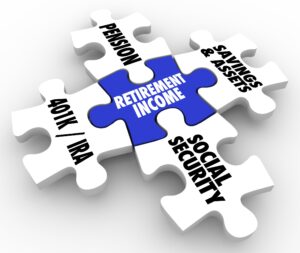
As a struggling student and young professional, I made many financial mistakes early on. One of the greatest regrets I have is not starting to invest sooner. Unfortunately, we can’t un-write our histories. Even though I was a late-comer in the investing game, I finally took action and started saving for retirement in my 30s. And, I have ambitious financial goals for both my business and my retirement savings. One of the most important questions I find myself asking as my portfolio expands is, which retirement accounts are best for me?
5 Types of Retirement Accounts for the Self-Employed
Every day, more people are choosing to leave corporate America and go into business for themselves. Based on recent numbers from the Bureau of Labor Statistics for 2022, there are more self-employed Americans than ever before (more than 10 million). While there is no denying the draw of working for yourself, it also presents significant financial challenges. One of the most challenging obstacles is figuring out how to save for retirement.
Retirement plans for the self-employed look a little different from those of the average person with a corporate job since you have to design and manage all of your retirement planning. Although there are still options available to you, it will restrict which types of accounts you can use. For example, you won’t benefit from employer-sponsored 401(k)s that offer contribution matching.
On the other hand, the possibility to build wealth can greatly exceed the limits of more traditional options. A well-chosen plan and steady stream of contributions will not only allow you to save more, but also help you bankroll your retirement years. Based on my personal experience and the advice of my financial advisors, I have narrowed down the best types of retirement accounts for the self-employed.
Roth IRA
One of the first accounts I opened was a Roth IRA. It seemed like the sensible place to start for the tax advantages alone. Not only does a Roth IRA offer tax-free income in retirement since you pay it upfront, but your contributions are also tax-deductible for the year you make them.
Furthermore, there are fewer penalties and restrictions if you need to access your funds. With this type of account, you can take early withdrawals without penalty from your contributions, as long as you don’t take anything from your earnings. Therefore, it works well as an emergency fund. And, they don’t require you to start taking withdrawals until you reach age 72.
While anyone can contribute to a Roth IRA, it does have one serious drawback. If you choose to invest in these accounts, you will only be allowed to contribute a maximum of $6,000 each year, or $7,000 if you are over 50. So even though it provides great benefits and incentives, it is not enough to serve as your primary source of retirement income.
SIMPLE IRA
SIMPLE IRAs, or Savings Incentive Match Plan for Employees IRA, are another popular choice among the self-employed. They were designed for small business owners and sole proprietors. Furthermore, they are relatively easy to set up and maintain due to fewer reporting requirements and less paperwork. Not only does this mean more convenience for you, but it also means it has lower costs to manage it.
Additionally, it allows the account holder to save more than they would with a traditional IRA. For 2022, you can make a maximum contribution of $14,000 annually, or$17,000 for people over 50. When calculating the maximum for both employer and employee contributions, you can put away a total contribution of $20,500 per year, or $27,000 for those over 50. These numbers vastly exceed what you can save with other types of retirement accounts since you can contribute as both employer and employee.
And, it is a tax-advantaged account. Your contributions are tax-deferred until you start taking withdrawal which also lowers your taxable income. And most importantly, there is no vesting. So when the money enters your account, it immediately belongs to you, no matter your future employment decisions.
SEP IRA
Although they are less common, a Simplified Employee Pension IRA is another great option for employers and the self-employed. Similarly to other IRAs, it reduces your taxable income and defers taxes until you receive distributions. And, it also provides immediate vesting for all contributions.
However, one feature makes them drastically different than the other types of retirement accounts: they are completely funded by the employer. This provides several benefits for both parties. The most important is that there is tax-deferred growth if you are the employee and tax-deductible contributions for the employer.
But like all things in life, it has limits. With a SEP IRA, the employer can’t exceed 25% of the employee’s earnings with a maximum of $61,000 for 2022. But even with the caps in place, it allows for substantially more savings than a traditional IRA.
Solo 401(k)
For those who already have these types of retirement accounts or prefer something more customizable, a Solo 401(k) may be the perfect solution. It can pair with other accounts to form a well-rounded retirement plan and has unlimited investment options. And, it still allows for Roth contributions, loans, and profit-sharing contributions to give generous contributions to specific employees. This also allows you to choose to take a tax-deductible deferral or the post-tax Roth deferral, based on your specific needs.
The Individual or Solo 401(k) also provides a better vehicle for building wealth since it has higher contribution limits. And, it allows you to contribute as both employer and employee. However, you can only contribute to a Solo 401(k) if you have no other full-time employees (other than your spouse). While it may be a little complex for some investors, it is a great way to get you closer to your retirement goals.
Health Savings Account
Since the self-employed also have to figure out their health insurance plans, a Health Savings Account gives us one more way to manage our finances. While it may seem an odd inclusion, it gives you more control over how and when you use the funds.
An HSA is an account associated with high-deductible insurance plans specifically used to cover out-of-pocket medical expenses. The money is tax-deferred and lowers your taxable income. Any unused funds automatically roll over into the following year where they will continue to earn interest, tax-free.
Although I typically use our HSA to cover our day-to-day medical expenses, it also has investing options. If you have money in your account, you can invest a portion of the balance in stocks, bonds, and mutual funds where you can earn even more towards your retirement.
Choosing the Right Retirement Accounts for You
The truth is that retirement planning is hard, especially if don’t have an employer contributing or managing the accounts. However, there is also exponentially more potential to grow your nest egg. But this depends on which type of retirement account you choose. While there is no one-size-fits-all answer, these are the most common financial vehicles for the self-employed. Discussing your options with your financial planner can help you discern which is best for your situation and help you plan for a secure future.
Read More
- How to Efficiently Manage Multiple Retirement Accounts
- How to Minimize Taxes After Retirement
- My Retirement Planning Panic Attack

Jenny Smedra is an avid world traveler, ESL teacher, former archaeologist, and freelance writer. Choosing a life abroad had strengthened her commitment to finding ways to bring people together across language and cultural barriers. While most of her time is dedicated to either working with children, she also enjoys good friends, good food, and new adventures.
